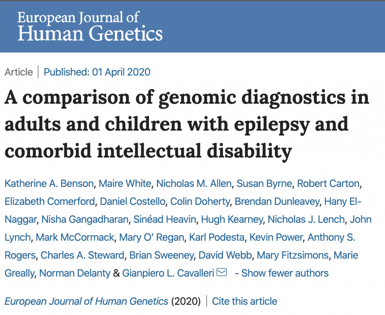A new collaborative study published in The European Journal of Human Genetics, “A comparison of genomic diagnostics in adults and children with epilepsy and comorbid intellectual disability”[1] by Benson et al, explores the utility of genomic diagnostics, using array-comparative genomic hybridisation (array-CGH) and whole exome sequencing (WES), in a cohort of 101 adult and paediatric epilepsy patients with co-morbid intellectual disability.
The study was designed specifically to look at adults compared with children because genetic epilepsies are less well understood and therefore still underused in the adult epilepsy clinic.
The Congenica clinical decision support platform was used in addition to an in-house bioinformatics pipeline, which allowed the identification of additional variants, increasing diagnostic yield. Here we discuss how this collaboration illustrates the importance of being able to correctly interpret the genomic sequence for epilepsy patients with complex phenotypes.
Epilepsy affects around 60 million people around the world and it is a common neurological disorder. In a significant number of people, up to 80%, their epilepsy is believed to be caused by changes in their genome. Some of these causes are the result of a variant in a single gene, which means that the causative variant can often be identified using genomic techniques, such as array-CGH and WES using next-generation sequencing. Large-scale sequencing studies that use these techniques, such as the Deciphering Developmental Disorders study, have already proven very successful for understanding the genomic cause in a significant number of cases of severe childhood epilepsies.
However, relatively little is understood about the diagnostic yield for both SNVs and CNVs and thus, the clinical utility of genomic testing in the adult epilepsy setting. One explanation for this is that there is little current knowledge whether children with such epilepsies, who survive into adulthood, have a different genetic cause for their epilepsy compared to those children who do not survive. It is also problematic trying to diagnose childhood epilepsies in adults as the disease may have continued to evolve and progress in different ways as to make the phenotype very different to that observed in the child.
Few studies have previously established the diagnostic yield of WES in adults with epilepsy and associated intellectual disability. Those that have, in some cases, may not have used the strict criteria set out in the American College of Medical Genetics and Genomics (ACMG) guidelines, which is an essential component of classifying disease-causing variants in a patient’s genome. As such, this would most likely have resulted in misleading diagnostic yields.
Using the ACMG guidelines, this study was able to report a diagnostic yield of 27% in adult patients and 42% in paediatric patients with an overall combined diagnostic rate of 31% for WES and array-CGH. This study also used a dual-bioinformatics pipeline where the in-house pipeline was used alongside Congenica software. Congenica identified all variants detected by the in-house pipeline as well as additional variants, leading to an increase in diagnostic yield and improved outcomes for more patients in the study.
Lead author, Dr Katherine Benson said, “By utilising Congenica we increased our diagnostic yield and delivered a molecular diagnosis to patients who would not have received one using our standard bioinformatic pipeline.” What is of particular interest is that 82% of the pathogenic and likely pathogenic variants were a result of de novo changes in the patients’ genomes, a known and significant pathogenic mechanism for epilepsy.
Of the 33 of patients who received a diagnosis, four of them were able to inform on specific gene-related therapy. For example, one patient with a TSC1 variant could be suitable for treatment with everolimus. Three patients who had variants in SCN1A will not be treated with sodium channel blockers, which are known to exacerbate seizures in patients with SCN1A variants. Furthermore, the remaining patients with a known underlying genomic cause could be eligible for other emerging therapy as well as being directed to specific gene-related support groups. Interestingly, this study found incidental findings in 2.7% of patients.
The study by Benson et al. provides novel insights into the role of genetic testing in the adult neurology clinic, specifically for epilepsy. It also complements and extends findings from previous publications and has important implications for the incorporation of diagnostic whole exome testing in the adult epilepsy clinic. This will be of particular interest to genomics researchers, clinicians in the field of epileptology and clinical geneticists.
It is hoped that this study will provide a useful platform to educate healthcare professionals about the advantages and promises that genomic medicine holds for both patients and healthcare systems.
Watch Dr Benson’s webinar, Maximizing Diagnostic Yield, on demand today:
References
1. Benson et al. (2020) A comparison of genomic diagnostics in adults and children with epilepsy and comorbid intellectual disability. European Journal of Human Genetics. https://doi.org/10.1038/s41431-020-0610-3




.png?width=320&height=192&name=Untitled%20design%20(8).png)
.png?width=320&height=192&name=Since%202016%2c%20the%20number%20of%20women%20working%20in%20STEM%20fields%20in%20the%20UK%20has%20increased%20by%20216%2c552%2c%20taking%20the%20total%20number%20over%20the%201%20million%20mark%20for%20the%20first%20time.%20Women%20now%20make%20up%2024%25%20of%20the%20STEM%20workforce%20i%20(2).png)
-1.png?width=320&height=192&name=Deciphering%20Developmental%20Disorders%20(1)-1.png)